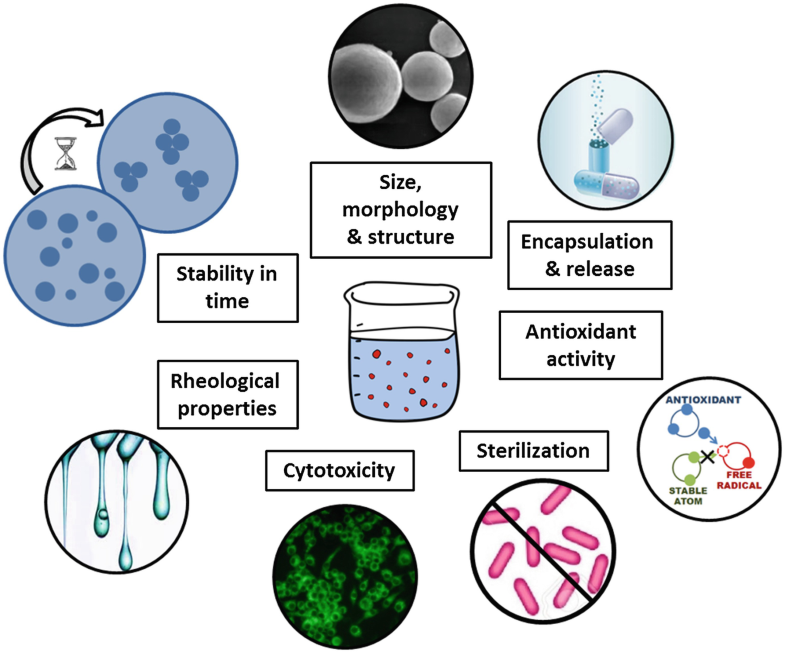Emulsion-based antioxidant carriers are widely used in the food industry and pharmacology. After designing and synthesizing a determined emulsion-based antioxidant vehicle, it is essential to physicochemically characterize it in order to check if it meets the expected requirements for each application. In this sense, a good understanding of the basis of characterization techniques and methods to evaluate the design and performance of these encapsulation systems is crucial. In this chapter, the main characterization techniques of emulsion-based antioxidant carriers for biomedical applications are presented. A wide variety of techniques used in the evaluation of both continuous and dispersed phases of the emulsion system have been reviewed, from stability, rheology, cytotoxicity or sterilization of the whole emulsion; to the specific study of properties such as morphology, structure or size of the dispersed phase. Special emphasis has been placed on the antioxidant activity of the carriers being the key advantage of these emulsion-based systems.
3729048
{3729048:5VPHGQ6D}
nature
50
1
1
title
897
http://www.biomateriales.ictp.csic.es/wp-content/plugins/zotpress/
%7B%22status%22%3A%22success%22%2C%22updateneeded%22%3Afalse%2C%22instance%22%3A%22zotpress-544a017185dc9c6367ff8ef0aaaa0ad8%22%2C%22meta%22%3A%7B%22request_last%22%3A0%2C%22request_next%22%3A0%2C%22used_cache%22%3Atrue%7D%2C%22data%22%3A%5B%7B%22key%22%3A%225VPHGQ6D%22%2C%22library%22%3A%7B%22id%22%3A3729048%7D%2C%22meta%22%3A%7B%22creatorSummary%22%3A%22Pontes-Quero%20et%20al.%22%2C%22parsedDate%22%3A%222020%22%2C%22numChildren%22%3A1%7D%2C%22bib%22%3A%22%3Cdiv%20class%3D%5C%22csl-bib-body%5C%22%20style%3D%5C%22line-height%3A%202%3B%20%5C%22%3E%5Cn%20%3Cdiv%20class%3D%5C%22csl-entry%5C%22%20style%3D%5C%22clear%3A%20left%3B%20%5C%22%3E%5Cn%20%3Cdiv%20class%3D%5C%22csl-left-margin%5C%22%20style%3D%5C%22float%3A%20left%3B%20padding-right%3A%200.5em%3B%20text-align%3A%20right%3B%20width%3A%201em%3B%5C%22%3E1.%3C%5C%2Fdiv%3E%3Cdiv%20class%3D%5C%22csl-right-inline%5C%22%20style%3D%5C%22margin%3A%200%20.4em%200%201.5em%3B%5C%22%3EPontes-Quero%2C%20G.%20M.%20%3Ci%3Eet%20al.%3C%5C%2Fi%3E%20%3Ca%20target%3D%27_blank%27%20href%3D%27https%3A%5C%2F%5C%2Fdoi.org%5C%2F10.1007%5C%2F978-3-030-62052-3_12%27%3ECharacterization%20Techniques%20for%20Emulsion-Based%20Antioxidant%20Carriers%20with%20Biomedical%20Applications%3C%5C%2Fa%3E.%20in%20%3Ci%3EEmulsion%5Cu2010based%20Encapsulation%20of%20Antioxidants%3A%20Design%20and%20Performance%3C%5C%2Fi%3E%20%28ed.%20Aboudzadeh%2C%20M.%20A.%29%20423%5Cu2013462%20%28Springer%20International%20Publishing%2C%20Cham%2C%202020%29.%20doi%3A10.1007%5C%2F978-3-030-62052-3_12.%20%3Ca%20title%3D%27Cite%20in%20RIS%20Format%27%20class%3D%27zp-CiteRIS%27%20href%3D%27http%3A%5C%2F%5C%2Fwww.biomateriales.ictp.csic.es%5C%2Fwp-content%5C%2Fplugins%5C%2Fzotpress%5C%2Flib%5C%2Frequest%5C%2Frequest.cite.php%3Fapi_user_id%3D3729048%26amp%3Bitem_key%3D5VPHGQ6D%27%3ECite%3C%5C%2Fa%3E%20%3C%5C%2Fdiv%3E%5Cn%20%3C%5C%2Fdiv%3E%5Cn%3C%5C%2Fdiv%3E%22%2C%22data%22%3A%7B%22itemType%22%3A%22bookSection%22%2C%22title%22%3A%22Characterization%20Techniques%20for%20Emulsion-Based%20Antioxidant%20Carriers%20with%20Biomedical%20Applications%22%2C%22creators%22%3A%5B%7B%22creatorType%22%3A%22author%22%2C%22firstName%22%3A%22Gloria%20Mar%5Cu00eda%22%2C%22lastName%22%3A%22Pontes-Quero%22%7D%2C%7B%22creatorType%22%3A%22author%22%2C%22firstName%22%3A%22Eva%22%2C%22lastName%22%3A%22Espinosa-Cano%22%7D%2C%7B%22creatorType%22%3A%22author%22%2C%22firstName%22%3A%22Daniel%22%2C%22lastName%22%3A%22Fern%5Cu00e1ndez-Villa%22%7D%2C%7B%22creatorType%22%3A%22author%22%2C%22firstName%22%3A%22Miguel%22%2C%22lastName%22%3A%22Huerta-Madro%5Cu00f1al%22%7D%2C%7B%22creatorType%22%3A%22author%22%2C%22firstName%22%3A%22Mar%5Cu00eda%20Rosa%22%2C%22lastName%22%3A%22Aguilar%22%7D%2C%7B%22creatorType%22%3A%22author%22%2C%22firstName%22%3A%22Blanca%22%2C%22lastName%22%3A%22V%5Cu00e1zquez-Lasa%22%7D%2C%7B%22creatorType%22%3A%22editor%22%2C%22firstName%22%3A%22M.%20Ali%22%2C%22lastName%22%3A%22Aboudzadeh%22%7D%5D%2C%22abstractNote%22%3A%22Emulsion-based%20antioxidant%20carriers%20are%20widely%20used%20in%20the%20food%20industry%20and%20pharmacology.%20After%20designing%20and%20synthesizing%20a%20determined%20emulsion-based%20antioxidant%20vehicle%2C%20it%20is%20essential%20to%20physicochemically%20characterize%20it%20in%20order%20to%20check%20if%20it%20meets%20the%20expected%20requirements%20for%20each%20application.%20In%20this%20sense%2C%20a%20good%20understanding%20of%20the%20basis%20of%20characterization%20techniques%20and%20methods%20to%20evaluate%20the%20design%20and%20performance%20of%20these%20encapsulation%20systems%20is%20crucial.%20In%20this%20chapter%2C%20the%20main%20characterization%20techniques%20of%20emulsion-based%20antioxidant%20carriers%20for%20biomedical%20applications%20are%20presented.%20A%20wide%20variety%20of%20techniques%20used%20in%20the%20evaluation%20of%20both%20continuous%20and%20dispersed%20phases%20of%20the%20emulsion%20system%20have%20been%20reviewed%2C%20from%20stability%2C%20rheology%2C%20cytotoxicity%20or%20sterilization%20of%20the%20whole%20emulsion%3B%20to%20the%20specific%20study%20of%20properties%20such%20as%20morphology%2C%20structure%20or%20size%20of%20the%20dispersed%20phase.%20Special%20emphasis%20has%20been%20placed%20on%20the%20antioxidant%20activity%20of%20the%20carriers%20being%20the%20key%20advantage%20of%20these%20emulsion-based%20systems.%22%2C%22bookTitle%22%3A%22Emulsion%5Cu2010based%20Encapsulation%20of%20Antioxidants%3A%20Design%20and%20Performance%22%2C%22date%22%3A%222020%22%2C%22language%22%3A%22en%22%2C%22ISBN%22%3A%229783030620523%22%2C%22url%22%3A%22https%3A%5C%2F%5C%2Fdoi.org%5C%2F10.1007%5C%2F978-3-030-62052-3_12%22%2C%22collections%22%3A%5B%5D%2C%22dateModified%22%3A%222021-03-11T10%3A18%3A05Z%22%7D%7D%5D%7D





